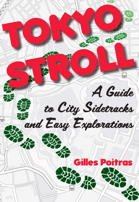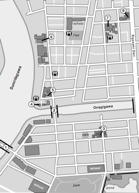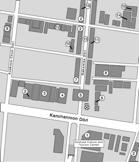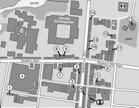











Tokyo Stroll Supplement: Odaiba / Aomi Area

This page is for locations in the Odaiba / Aomi Area of Tokyo. This neighborhood is not part of my book Tokyo Stroll.
For information on Tokyo Stroll ands web supplement see Tokyo Stroll Supplement home page
For users of the Organic Maps, Maps.Me and Google Maps apps the items below have bookmarks you can import into those apps to make navigation easier.
Instructions and links are on the Viewing Locations in Organic Maps, Maps.Me, Google Maps, or Google Earth page.
Some entries on this page may include a note that says "Description to be added soon ." These entries are for items I felt should be listed even if the description is not ready to assist those who wish to plan a trip. When possible I included a link to an official web page, I suggest also doing web searchs for more information.
The Odaiba / Aomi Area falls into two wards, Minato-ku and Kōtō-ku. Like much of the land here and to the north this area is landfill and was later built into a major residential, leasure and commercial area. Much of southern Aomi is devoted to docks, freight yards, and warehouses
ACCESS: Tokyo Teleport Station (Rinkai Line), several stations on the Yurikamome Line.
FCG Building [Fuji Television Network] (FCGビル [㈱フジテレビジョン])
The headquarters for one of Japan's major TV networks, the building was designed by Tange Kenzō and completed in 1996. The open structure of the building makes it a major landmark for Odaiba. The titanium sphere has two stories; the top one is “HACHITAMA” a spherical observation room on the "25th floor" accessed until 6 pm with a ticket, the lower one is a TV studio which when not in use can be visited. There is also a fifth floor gallery for exhibits and several shops on the first and seventh floors.
NEAREST TRAIN/SUBWAY STATION: Daiba Station (Yurikamome Line), Tokyo Teleport Station (Tokyo Waterfront Area Rapid Transit (Rinkai Line)
CLOSED: Mondays, open if Monday is a holiday and closed Tuesday.
WEB: https://www.fujitv.com/visit_fujitv/
Rainbow Bridge (レインボーブリッジ)
A major suspension bridge connecting Shibaura on the west side and Odaiba on the east. It was designed so the towers were not too high since Haneda Airport is close by, the bridge also needed to be wide and tall enough to allow large ships to go under. This led to a decision to use a suspension design. At night the bridge is lit up, colored lights are used in December. Construction began in 1987 and the bridge went into service on August 26, 1993. There are two decks one for the Shuto Expressway No 11 the other for a local Tokyo roadway, the Yurikamome automated guideway transit service, and pedestrians. At 798 meters (72.66 yards long) long the bridge is just shy of a mile long, the pedestrian walkways are longer at 1.7 km (roughly one mile). The walkways are on either side of the bridge so decide if you want a north of south view as you cannot cross from one to the other. The east side of the bridge has a visitor center with two elevators to the walkways, one for each side. The walkways are closed on windy days and at night, before 9 PM in summer and before 6 pm in winter. There are benches in middle so you can rest and enjoy the view, pets are not allowed on the bridge. Bikes must be walked and are attached to a wooden trolly to prevent riding which is removed when you leave the walkway. To go to Odaiba bikes can only be used on the southern side of the bridge, to go to Shibaura use the northern side. Such a major landmark is often seen in anime, manga, and cinema created after its completion.
NEAREST TRAIN/SUBWAY STATION: Odaiba-kaihinkōen Station (Yurikamome Line), Shibaura-futō Station (Yurikamome Line)
WEB: https://www.shutoko.jp/fun/lightup/rainbowbridge/
Statue of Liberty (自由の女神像)
At 12.192 meters tall (40 feet) tall the statue is roughly 1/7 the size of the New York statue. In 1998 and 1999 a replica of the Statue of Liberty that is on Île aux Cygnes in Paris was temporarily displayed in Odaiba to celebrate the friendship between Japan and France. After that statue was returned a replica of the replica was placed here in 2000. The nearby on windy days at nightRainbow Bridge Observation Deck is a popular place to photograph the statue.
NEAREST TRAIN/SUBWAY STATION: Daiba Station (Yurikamome Line)
Tokyo Wangan Police Station (東京湾岸警察署)
This police station opened in March 31, 2008. During the planning process a survey of local residents resulted in the station being named after the fictional Wangan Police Station in the highly successful Bayside Shakedown (Odoru Daisōsasen) TV and movie series set in the Wangan area. To avoid copyright conflicts with Fuji Television's show Tokyo was added to the station's name. As this is just a police station I imagine those visiting will be fans of the TV show and movies.
NEAREST TRAIN/SUBWAY STATION: Tokyo International Cruise Terminal Station (Yurikamome Line)
WEB: https://www.keishicho.metro.tokyo.lg.jp/about_mpd/shokai/ichiran/kankatsu/tokyowangan/index.html
Unicorn Gundam Statue (実物大ユニコーンガンダム立像)
A full sized statue of the title Gundam unit from the Mobile Suit Gundam Unicorn novel and anime series. The statue is 19.7 meters (64.63 feet) tall and it was unveiled, if that term can be used for such a large statue, in September 2017. Several times a day the statue transforms into the destroyer mode, at night internal lights are visible during the transformation. This statue replaced the older RX-78-2 Gundam statue that had been in the same location.
NEAREST TRAIN/SUBWAY STATION: Tokyo International Cruise Terminal Station (Yurikamome Line), Tokyo Teleport Station (Tokyo Waterfront Area Rapid Transit (Rinkai Line)
WEB:https://www.unicorn-gundam-statue.jp
Back to the Tokyo Stroll Supplement home page - Privacy Notice - Back to Gilles' home page
Created October 20 | Content last updated September 21, 2025